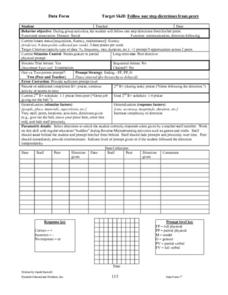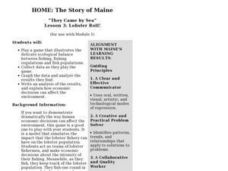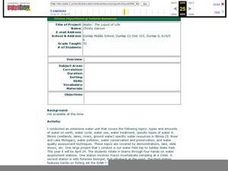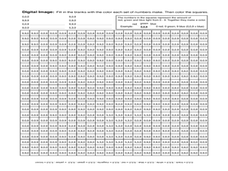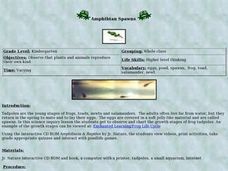Curated OER
Follow One Step Directions From Peers
Middle schoolers practice taking directions from their peers during group activities. With teachers, they practice the directions and then gradually start practicing with their mainstream friends. They are given marks on a chart noting...
Curated OER
Database Detectives Solve a Mystery ~ Part 2
Students work together to solve a classroom mystery. They collect and organize their information into databases. They educate the school on how databases benefit life in a democracy.
Curated OER
Lesson 3: Lobster Roll!
Students play a game that illustrates the delicate ecological balance between fishing, fishing regulations and fish populations. They collect data and analyze the results.
Curated OER
Surveying Our Media
Students participate in a lesson that is concerned with the concept of examining the use of media in society. They create surveys to measure the presence of the media in everyday life. The results are collected and represented in the...
Curated OER
Every Tree For Itself
Fourth graders play a game where they are trees gathering sun, water, and nutrients and CO2 represented by pieces of paper or poker chips. They record their collected requirements and graph how they grew as a forest.
Curated OER
Melody Words
Fourth graders compose a melody by placing words on the music staff. They play their melody words for the class.
Curated OER
Water: The Liquid of Life
Sixth graders complete a lesson on the properties, types and amounts of water on Earth. In groups, they travel between stations to identify water resources in Illinois and pollution sources. They complete the lesson with a field trip...
Curated OER
Pausing to Breathe
Young scholars identify and summarize the critical aspects of each of the four topics on air pollution. They present these critical components in an interesting and creative manner to class members.
Curated OER
Sweet or Sour, Like or Different
Students watch a video on comparisons and discuss ways in which objects can be sorted. They play an identification game with a lemon and discuss identification characteristics.
Curated OER
Imagers: The Adventure of Echo the Bat Number to Pictures: How Satellite Images are Created
Young scholars examine the three primary colors of light and design a numerical code to represent those colors. They tell how satellites use numbers to create satellite images after completing a number of experimental activities.
Science 4 Inquiry
Carbon and Climate
The carbon cycle is natural and has happened for millions of years, so can humans change it? Young scientists play the role of carbon as they travel through the carbon cycle. They complete two rounds, once before the industrial...
Science 4 Inquiry
States and Phases of Matter
Plasma is the most common phase of matter in our universe. Scholars explore the change of energy as molecules change phases of matter. They rotate through stations, graphing the changes in energy level.
Curated OER
Express Yourself
Sixth graders write to Key pals. In this description instructional activity, 6th graders describe a place to their key pals and the pal has to draw a pictures based off their description. They also create a Fun Facts Worksheet about...
Curated OER
Coin Shake-Up
Students discuss problem and take turns in pairs, one tossing the coins while the other guesses whether the coins land with the same side up or different sides up. They record the results of each guess as same or different.
Curated OER
You Bet!
Learners explore the mathematical probabilities involved in gambling and how these factors affect people's behavior. They work in pairs and conduct and experiment pertaining to blackjack. The class creates a graph showing the trends found.
Curated OER
Amphibian Spawns
Students observe tadpoles as they gradually change into adults. For this amphibian biology lesson, students watch tadpoles in a tank in the classroom, keep a daily record of what they observe, and chart the growth development of the...
Curated OER
Making a Map of the Classroom
Middle schoolers create a map of the classroom using the computer programs AppleWorks and iChat in this math-based technology instructional activity. Lesson extension ideas include a scavenger hunt and maps of other school buildings.
Curated OER
The Dentist
Students read a short story about visiting a dentist. Then they use toothbrushes in order to demonstrate the correct way to brush teeth. Students use the internet to investigate how some foods are healthier for teeth than others. Then...
Curated OER
Hide and Seek
Students examine animals that use camouflage and discuss why they use it. They create drawing of an imaginary animal that uses camouflage to hide in the classroom and identify the adaptations that would allow it to hide effectively.
Curated OER
Which Objects Will Sink or Float?
First graders work in cooperative groups and utilize a variety of materials to test objects ability to sink or float. In this sink or float lesson, 1st graders discover why some object sink and others float. Students will graph results...
Curated OER
Understanding Interactions Among Local Species and the Local Environment
Students examine the differences between biotic and abiotic factors, explain the difference between habitat and niche and compare how organisms get their nutritional needs. In this local environment activity students trace the path of...
Curated OER
Plugged in to CO2
Learners use a meter to measure the energy used and carbon produced by electronics and appliances. In this environmental science and technology lesson, students use a Kill-A-Watt meter to determine the electricity used by everyday...
Curated OER
Chatter
Students discover that cultural norms heavily influence how we communicate. They experience the challenge of using and interpreting unfamiliar communication patterns.
They identify strategies for successful cross-cultural communication.
Curated OER
Mobile Phones
Investigate how mobile phones impact their lives through this technology instructional activity that has students discuss the history of the cell phone and research how cell phones are being used in third world countries. Students create...


